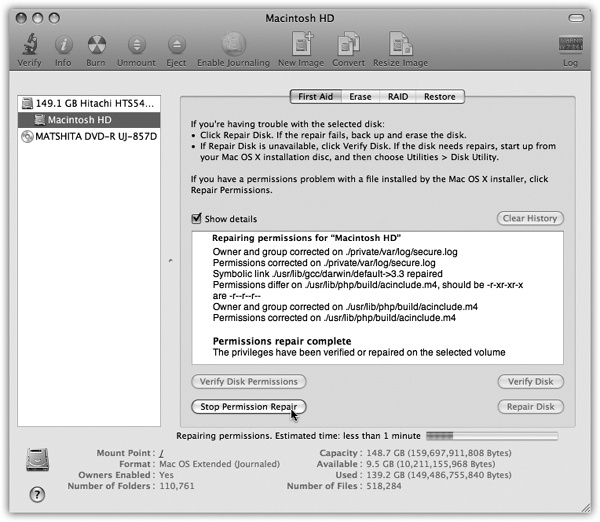All kinds of glitches may befall you, occasionally, in Mac OS X. Your desktop picture doesn’t change when you change it in System Preferences. A menulet doesn’t open when you click it. A program won’t open—it just bounces in the Dock a couple of times and then stops.
When a single program is acting up like this, but quitting and restarting it does no good, try the following steps, in the following sequence.
An amazing number of mysterious glitches arise because the permissions of either that item or something in your System folder—that is, the complex mesh of invisible settings that describe the Mac’s underlying Unix files—have become muddled.
When something doesn’t seem to be working right, therefore, open your Applications→Utilities folder and open Disk Utility. Proceed as shown in Figure B-1.
This is a really, really great trick to know.
Figure B-1. Click your hard drive’s name in the left-side list, click the First Aid tab, click Repair Disk Permissions, and then read an article while the Mac checks out your disk. If the program finds anything amiss, you’ll see messages like these. Among the text, you may recognize some Unix shorthand for read, write, and execute privileges.
If a program starts acting up immediately after you’ve installed it, chances are good that it has some minor incompatibility. Chances are also good that you’ll find an updated version on the company’s Web site.
A corrupted preference file can bewilder the program that depends on it.
Before you go on a dumpfest, however, take this simple test: Log in using a different account (perhaps a dummy account that you create just for testing purposes). Run the problem program. Is the problem gone? If so, then the glitch exists only when you are logged in—which means it’s a problem with your copy of the program’s preferences.
Return to your own account. Open your Home→Library→Preferences folder, where you’ll find neatly labeled preference files for all the programs you use. (To open the hidden Library folder, press the Option key as you open the Go menu; choose Library.)
Each preference file ends with the file name suffix .plist. For example, com.apple.finder.plist is the Finder’s preference file, com.apple.dock.plist is the Dock’s, and so on.
Put the suspect preference file into the Trash, but don’t empty it. The next time you run the recalcitrant program, it will build itself a brand-new preference file that, if you’re lucky, lacks whatever corruption was causing your problems.
If not, quit the program. You can reinstate its original .plist file from the Trash, if you find that helpful as you pursue your troubleshooting agenda.
Remember, however, that you actually have two Preferences folders. In addition to your own Home folder’s stash, there’s a second one in the Library folder in the main hard drive window (which administrators are allowed to trash; this one contains system-wide preferences, like your network configuration).
In any case, the next time you open the sick program or log in, the Mac creates fresh, virginal preference files.
Sometimes you can give Mac OS X or its programs a swift kick by restarting the Mac. It’s an inconvenient step, but not nearly as time-consuming as what comes next. And it can fix problems that cropped up when you started up the computer.
Sometimes reinstalling the problem program clears up whatever the glitch was.
First, however, throw away all traces of it. Open the Applications folder and drag the program’s icon (or its folder) to the Trash. In most cases, the only remaining pieces to discard are its .plist file (or files) in your Home→Library→Preferences folder, and any scraps bearing the program’s name in your Library→Application Support folder. (You can do a quick Spotlight search to round up any other pieces.)
Then reinstall the program from its original disc or installer—after first checking the company’s Web site to see if there’s an updated version, of course.

